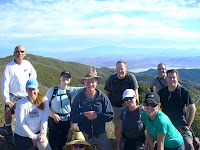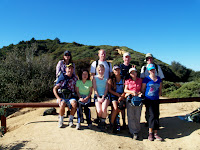In our previous article,"Grand Canyon Three Day Trip with HikingOC", we mentioned about the scenic and challenging hiking trails of the South Rim that take us into the inner canyons. The second day of our three day trip is our main hiking day where we will explore the famous trails of Grand Canyon (GC)--South Kaibab and Bright Angel trails. Since our group has different hiking levels, we will gather in four subgroups: beginning, intermediate, intermediate-plus and advance.
You can check here to find out your hiking level: What is the difference between skill levels?
If you are new to the meetup, please make sure that you join the hosting organizers for at least one hike prior to the trip to determine which group level you should belong to. During the trip, we recommend that you stay with the group in which you have been trained to hike with Lyrid Meteor Shower + Hiking Grand Canyon South Rim (All Levels-Camping/Lodging)
Hiking the Grand Canyon is a great experience. However, without proper training and preparation, sad news likes this can happen: Newlywed dies after Grand Canyon fall
We highly recommend that you hike with a group to the inner canyon unless you'd like to take time strolling around the park. Except for the beginning and intermediate groups, we all start together at the South Kaibab trailhead, but each group will have a different returning point. The advance group will hike the loop after descending the South Kaibab trail and starting to hike up the Bright Angel trail from the river at elevation 2480ft (around 10AM to noon time, it is the hottest time of the day in the canyon) while other groups start from the top of this trailhead at elevation 6860ft around 9AM. The intermediate-plus group will meet up with the advance group at the midpoint of the uphill trail and hike up together.
Here are approximate distance, elevation gain/loss, and total hiking time for each group:
1. Advance group: 17-20 miles, has about 4400-5000ft (gain/loss). Duration: ~ 7-10 hours 2. Intermediate-plus group: 12.6-15.6 miles, has about 4500-5000ft (gain/loss). Duration: ~ 7-10 hours
3. Intermediate group: 6-9.2 miles, has about 2300-3300ft (gain/loss). Duration: ~ 6-8 hours
4. Beginning group: 3-5 miles, has about 1000ft (gain/loss). Duration: ~ 3-5 hours
Prior to the hike, at the campsites, we will discuss and confirm our hiking plan with other members and organizers. We start our hikes immediately after viewing the Meteor Shower in the early morning.
Since the shuttle bus leave on the hour in the early morning, it is critical to start on time. If we miss the shuttle bus, we will be delaying our hike by one hour and the hike up is brutal in the heat of the day. Page 9 of spring guide has a shuttle map for the route from the visitor center to the South Kaibab trailhead: Grand Canyon the Guide Spring 2012
After getting off the shuttle, we will have to walk 0.8 miles to get to the trailhead. A cautious note to those who haven't hiked the South Kaibab trail before, it is very steep down hill.
The South Kaibab trailhead's elevation is 7260ft above sea level (Orange County is at sea level). The trail is on the ridge line and starts with series switchbacks. Prepare yourself for the change of elevation if you have altitude sickness. Also prepare for a desert climate--dry, cold morning and hot during the day. There will not be a water filling station until we get to the campground (adding 1 mile round trip) or after 5 miles up to Indian Garden on the Bright Angel trail. There are no shades on the entire trail. You should pace yourself as this is an "upside down" hike. The route from the trailhead to the river is 6.5 miles down hill with 4800ft elevation loss. The first highlight of the trail is Cedar Ridge at about 1.5 miles mark--a loss of 1150ft from the start of the trail. This is the turning point if you don't plan on hiking the entire trail. The advance group continues on to the next highlight, Skeleton Point (another 1.5 miles and a loss of 900ft); then to the next landmark, Tiffoff (another 1.4 miles and 800ft loss), this is the last segment before getting to the river which is 2.1 miles and another 1500ft drop. Estimate hiking time is about 3-5 hours to complete this route.
Here are details of the trail: the South Kaibab Trail and the South Kaibab Trail Map
Here are details of the trail: the South Kaibab Trail and the South Kaibab Trail Map
While the advance group continues hiking to the river on the South Kaibab trail, the other groups returning from the trail will take the shuttle bus back to the Bright Angel trailhead and meet the intermediate level group at 9AM.
 Bright Angel trailhead is at elevation 6860ft above sea level, a bit lower than the South Kaibab trail. This is the most crowded hiking trail of the South Rim. Views from this trail follow the head of the canyon--the massive cliffs, and a bit shadier trail with natural water sources and there is more plant life and animal life along the trail than on the South Kaibab trail. These features make this trail appealing to those interested in geology and in viewing wildlife. There are water refill options at Mile-and-a-Half Resthouse* (1.6 miles, descent 1131ft); Three-Mile Resthouse** (another 1.5 miles with almost 1000ft loss) and at Indian Garden (adding 1.7 miles and 950ft loss). The beginners and the intermediate groups can pick the turning point at (*), (**) or earlier at your comfortable limit. Round trip for the route to (*) is 3.2 miles steep both down and up hills or (**) is 6.2 miles. Upon coming back, these groups can take the shuttle to Yavapai Point and hike a little bit more to see the Colorado river and Phantom Ranch.
Bright Angel trailhead is at elevation 6860ft above sea level, a bit lower than the South Kaibab trail. This is the most crowded hiking trail of the South Rim. Views from this trail follow the head of the canyon--the massive cliffs, and a bit shadier trail with natural water sources and there is more plant life and animal life along the trail than on the South Kaibab trail. These features make this trail appealing to those interested in geology and in viewing wildlife. There are water refill options at Mile-and-a-Half Resthouse* (1.6 miles, descent 1131ft); Three-Mile Resthouse** (another 1.5 miles with almost 1000ft loss) and at Indian Garden (adding 1.7 miles and 950ft loss). The beginners and the intermediate groups can pick the turning point at (*), (**) or earlier at your comfortable limit. Round trip for the route to (*) is 3.2 miles steep both down and up hills or (**) is 6.2 miles. Upon coming back, these groups can take the shuttle to Yavapai Point and hike a little bit more to see the Colorado river and Phantom Ranch. The intermediate-plus group can go on to the Indian Garden and may optionally hike another 1.5 miles to the Plateau Point looking down the Colorado River. It is approximate 3-6 hours to get to Indian Garden for those who are interested in Plateau Point optional hike. If we coordinate our pace well, we will meet up with the advance hikers at Indian Garden rest stop, refill water and complete our hike up hill together (4.8 miles, about 3100ft gain). This is detailed information on the Bright Angel Trail and the Bright Angel Trail Map
If we have completed our planned hikes for the day before 5 PM, we can ride a shuttle bus to the scenic route, Hermit Road. The sunset view here is both relaxing and breath-taking. We can choose either Hopi Point, the one that attracts the crowds and buses, or the quieter, Mohave Point, to view the sunset and see the dynamic views of the canyon.
Everyone will probably feel tired because it has been a really long day (3AM to 7PM), but we also feel great that we hiked the South Rim trails. After completing all the day's activities, we will have a group dinner, then a (non-group) shower before resting by the campfire. Happy time to all!
Here are couple more maps of the South Rim trails:
1. Grand Canyon South Rim Topo Map
2. Grand Canyon South Rim Trails Map
1. Grand Canyon South Rim Topo Map
2. Grand Canyon South Rim Trails Map









































